When you're looking to add charm to your living room, it's crucial to start with a clear vision of your style, whether that's modern, farmhouse, or something uniquely yours. You'll want to choose furniture that not only fits this aesthetic but also prioritizes comfort. But that's just the beginning; there are several other elements that can transform the space into a warm and inviting haven. Curious about how to balance colors, incorporate texture, and optimize lighting to create the perfect ambiance? Keep going to uncover the details that can truly elevate your living room.
Essential Insights
- Incorporate a variety of textures and patterns with textiles, rugs, and wall treatments to create visual interest and warmth.
- Choose a statement piece of art or decor as a focal point to enhance the room's character and charm.
- Utilize layered lighting, combining ambient, accent, and task lighting to create a cozy and inviting atmosphere.
- Arrange seating to face inward, fostering conversation and connection among guests while defining the space's purpose.
- Add personal touches, such as family photos or travel souvenirs, to infuse personality and warmth into the living room.
Choose the Right Furniture
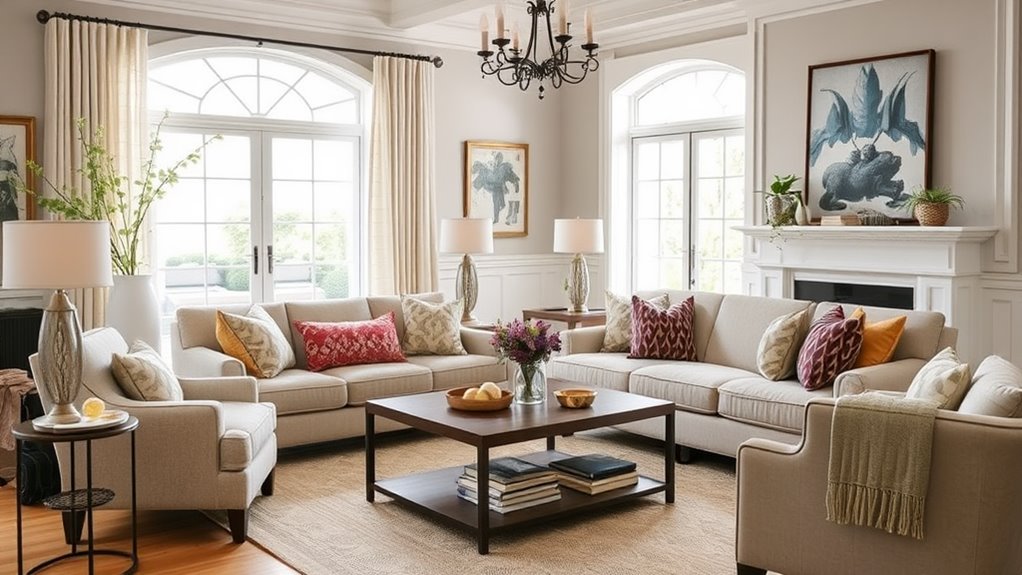
When it comes to choosing the right furniture for your living room, starting with a clear vision of your desired style is essential. Whether you lean towards modern, minimalist, traditional, or farmhouse aesthetics, having a defined style will guide your furniture selection. This cohesive approach guarantees that your living room feels harmonious and well thought out.
Once you've established your style, measure the room's dimensions. This will help you choose furniture that fits without overcrowding the space. Aim for a balanced arrangement that allows easy movement, leaving at least 18 inches around seating for comfort. Measuring your space accurately ensures that you select pieces that fit perfectly within the room's layout.
Identify focal points like a fireplace or large window, and use area rugs to define seating areas effectively.
Prioritize seating comfort by selecting sofas and chairs that invite relaxation. Look for durable, stain-resistant fabrics if you have children or pets. Don't shy away from mixing and matching furniture styles; just make sure that everything ties together in your chosen aesthetic.
Consider multifunctional pieces, like ottomans with storage or coffee tables with shelves, to enhance functionality.
Also, pay attention to proportions. Oversized furniture can dominate a space, while undersized pieces may get lost. Selecting a complementary color palette will enhance the mood of the room, while a variety of textures and materials adds depth.
Optimize Lighting
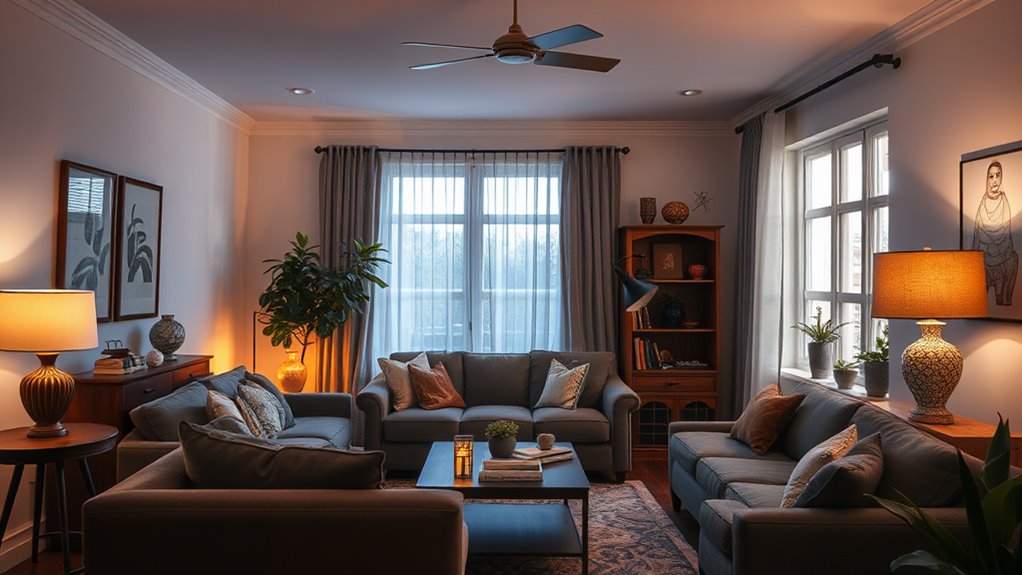
Effective lighting can transform your living room, creating an inviting atmosphere that enhances both functionality and style. To achieve the perfect balance, you should focus on a combination of ambient and accent lighting. Start with general lighting; consider using downlights or track lighting for overall illumination. Dimmable ceiling lights, like pendant lamps or chandeliers, can serve as stunning focal points, while wall lights brighten dark walls and add an airy feel. Modern fixtures can significantly improve visibility in your space, making it both stylish and practical.
Next, incorporate task lighting for specific activities. Position table lamps next to seating areas to provide light for reading or hobbies. Swing-arm lamps are a versatile choice, allowing you to direct light precisely where it's needed. Floor lamps with reading arms can also be effective in providing focused illumination.
Here's a quick overview of lighting options to optimize your living room:
| Lighting Type | Suggestions |
|---|---|
| General Lighting | Downlights, chandeliers, wall lights |
| Ambient Lighting | Table lamps, floor lamps, sconces |
| Task Lighting | Desk lamps, swing-arm lamps |
| Accent Lighting | Spotlights, picture lights, LED strips |
| Decorative Touches | Torchiere-style lamps, edge lighting
Play With Texture and Pattern
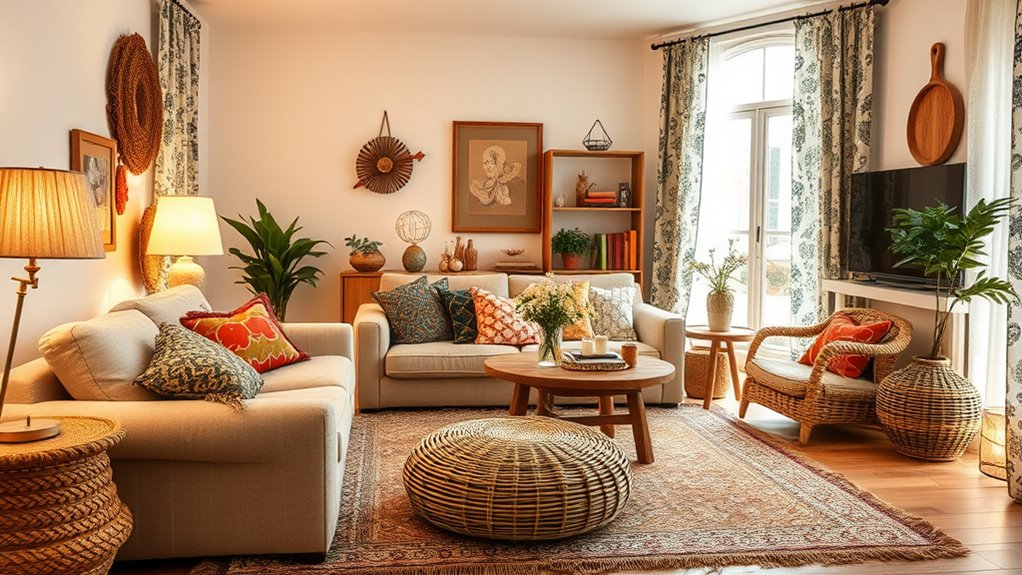
To elevate your living room's charm, play with texture and pattern to create a visually rich environment. Start by incorporating various texture techniques on your walls. You might consider using comb texture to add unique patterns or exposed brick for an industrial vibe. Rustic elements like stucco or concrete can also bring depth, while natural materials such as marble or wooden accents enhance warmth. Adding a touch of textured metallic finishes can also introduce a glamorous element that complements the overall design.
Next, don't shy away from pattern mixing. Geometric wallpaper can provide a modern touch, and mixing it with grasscloth can offer a cozy contrast. Rattan-inspired wallpaper blends seamlessly with neutral tones, adding subtle character without overwhelming the space. Experiment with texture-effect paint, like cement or lacquered finishes, to add depth to your walls.
Adding dimension with 3D wall panels can also elevate the aesthetic. Choose materials that complement your existing decor, such as wooden panels to create interesting patterns or geometric trims to define zones within the room. If you're looking for a glam effect, consider marble-like panels paired with gold accents or sconce lights.
Lastly, remember that balance is key. While you want to play with different textures and patterns, make certain they work harmoniously together. A well-curated mixture won't only enhance the charm of your living room but also create an inviting atmosphere that reflects your personality.
Balance Colors and Neutrals
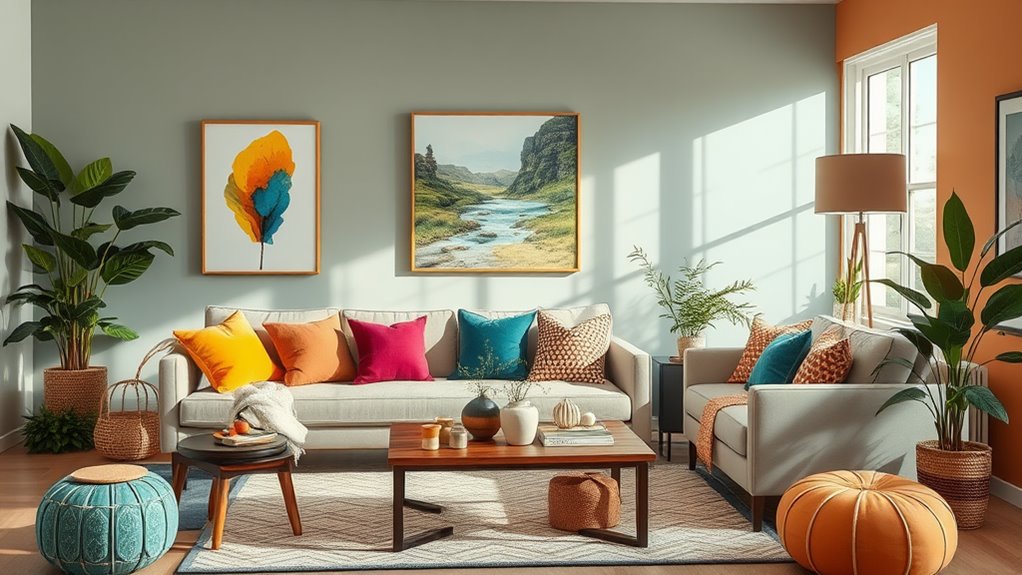
Balancing colors and neutrals in your living room is essential for creating a harmonious and inviting space. Start by applying the 60-30-10 rule: use a dominant color for about 60% of the room, typically on walls or floors. Choose a secondary color for 30% of the space, like furniture or rugs, to add depth. Finally, incorporate an accent color for 10% of the room through smaller items like throw pillows and artwork. This structure helps maintain visual balance while allowing for personal expression.
Next, consider selecting neutral colors like beige, gray, or taupe. These shades create a calming atmosphere and serve as a versatile backdrop for bolder accents. Neutral colors can easily balance out vibrant hues, making your space feel cohesive rather than overwhelming. The 60-30-10 rule is a great guideline to simplify color selection and ensure a well-balanced design.
Use the color wheel to explore complementary combinations that create dynamic contrasts. Alternatively, try analogous colors for a more soothing effect.
Don't shy away from integrating patterns and textures as well; this adds depth and interest while maintaining harmony in your color combinations. Choose fabrics, woods, and metals that complement each other without competing for attention. You can even use a monochromatic scheme, varying shades of the same color, to unify the look.
Ultimately, keep in mind the principles of color psychology as you choose combinations that reflect the mood you want your living room to convey. Balancing colors and neutrals will enhance your living room's charm, making it a delightful retreat.
Ensure Proper Layout and Flow
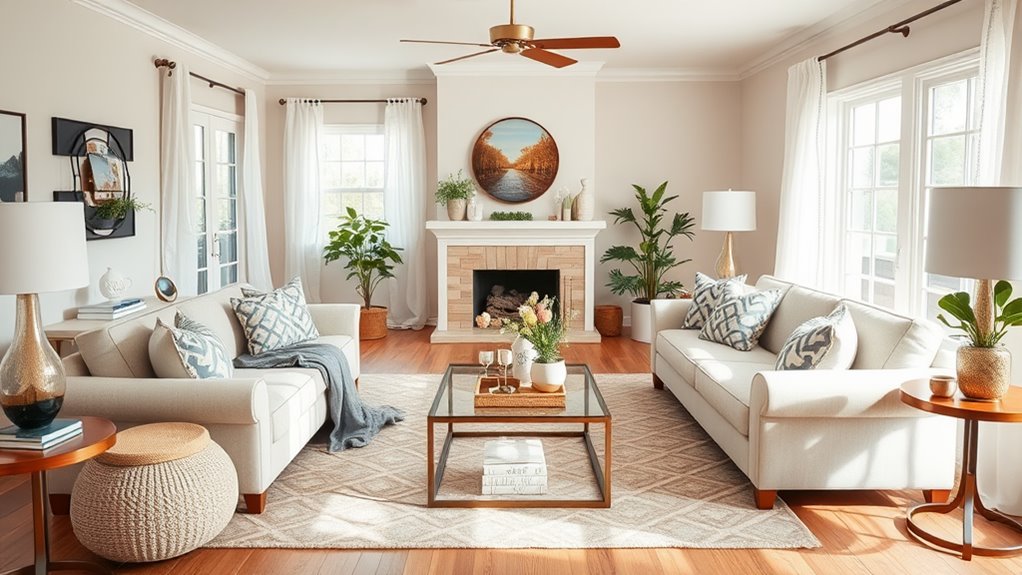
Creating a charming living room goes beyond just color; it also hinges on the layout and flow of the space. First, define the purpose of the room. Will it be used for entertaining, family time, or perhaps as a cozy reading nook? Identifying these primary activities helps you determine an effective furniture arrangement.
If your living room serves multiple functions, consider space zoning to utilize the area efficiently. Use area rugs or strategically placed sofas to divide the room into distinct sections.
When optimizing furniture placement, keep large pieces away from doorways to avoid blocking pathways. Aim for at least 18"-24" of walkway between large furniture items, or 30″-36″ when possible. Leave about 1 meter of space between furniture and walls for easy movement, ensuring that high-traffic areas remain clear.
Creating conversation areas enhances the room's charm. Arrange seating to face inward, fostering intimacy, especially in open-plan layouts. Identify a focal point, like a fireplace or large window, and position furniture around it.
In larger rooms, group sofas and chairs to form multiple conversation areas, using a round coffee table to soften linear lines and improve flow.
Add Decorative Elements
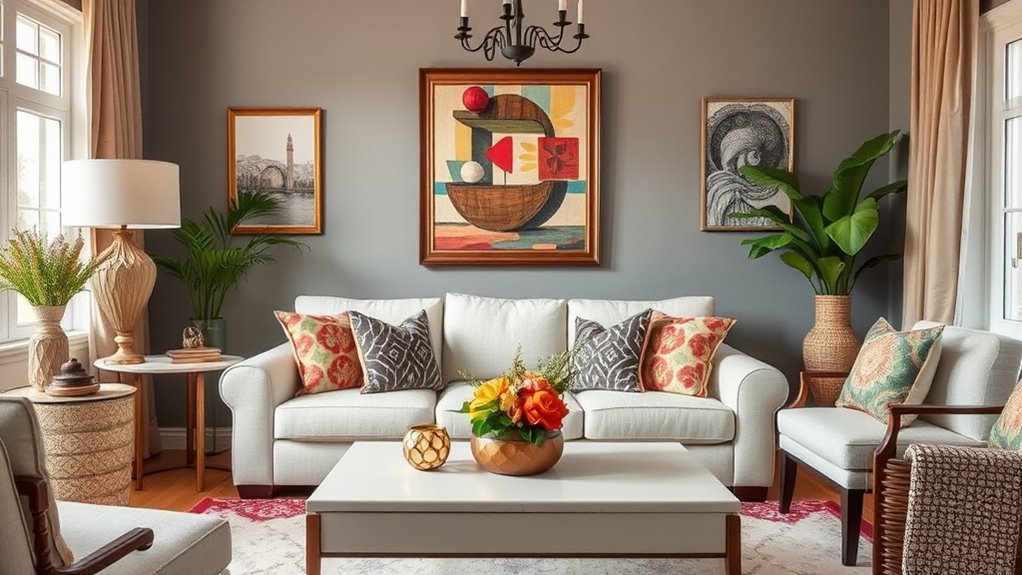
Decorative elements can transform your living room from ordinary to extraordinary. Integrating artwork variety and unique accessories not only enhances aesthetics but also creates inviting focal points. Start by selecting large-scale art pieces that complement your room's color scheme. Hang them above your sofa to draw the eye upward. Mix in photographs, textiles, and sculptures to add depth and variety.
Consider the following table to help visualize your options:
| Type of Element | Examples | Effect |
|---|---|---|
| Artwork | Abstract art, floral patterns | Enhances style and mood |
| Textures | Throws, cushions, rugs | Adds warmth and comfort |
| Patterns | Striped walls, abstract curtains | Creates visual interest |
| Focal Points | Fireplaces, statement furniture | Centers the room's design |
Introduce patterns and textures through various fabrics, like cozy throws and patterned cushions. Combine materials such as wood and marble to enrich the visual experience. Create a focal area with a striking piece of furniture or a well-stocked bookcase that draws attention.
Lastly, don't forget to play with color and lighting. Use vibrant hues to create a mood of comfort and relaxation while balancing them with neutral shades. Bright lighting can enhance your decor, making your living room feel warm and inviting. By carefully adding these decorative elements, you'll create a charming and comfortable space that reflects your style.
Incorporate Additional Seating
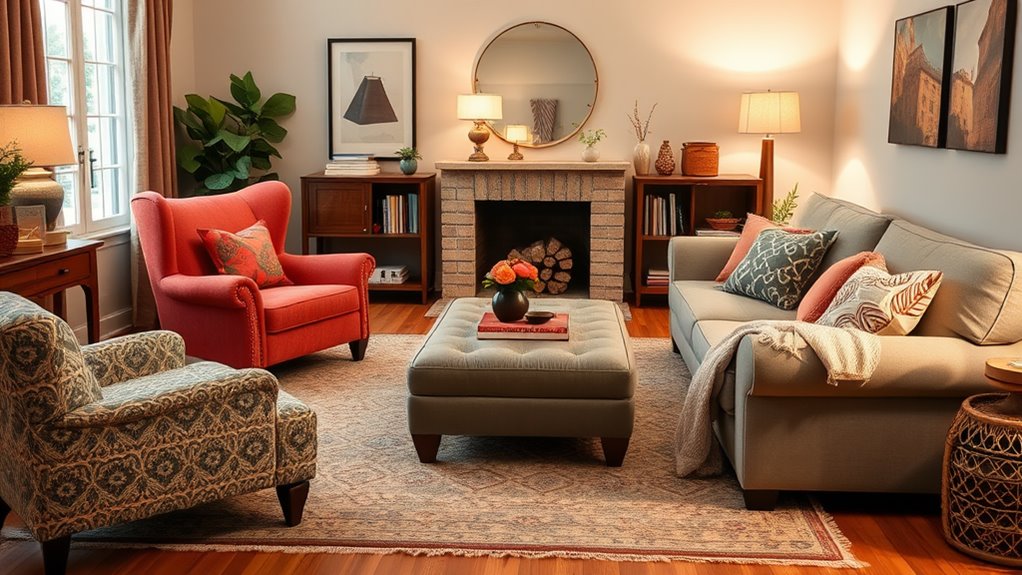
Your living room's charm can be greatly enhanced by incorporating additional seating, making the space more inviting and functional.
By choosing the right pieces, you can create a cozy atmosphere while maximizing comfort. Focus on space saving solutions and versatile designs that can adapt to your needs.
Here are three ideas to contemplate:
- Multipurpose Furniture: Opt for furniture that serves multiple functions, like ottomans that can act as seats, coffee tables, or footrests. A sofa with a built-in bench cushion can also increase seating capacity without taking up too much room.
- Compact Seating: Include slipper chairs or poufs that fit snugly in tight spaces. Stackable stools are another great option, as they can be used as side tables or extra seating when needed. These pieces add charm without overwhelming your space.
- Utilize Nooks: Make the most of any available corners or alcoves. A built-in bench seat under a window or a cozy nook with scatter cushions can create inviting spots for relaxation.
Tucking single-seat ottomans into corners or under tables adds both style and practicality.
Use Movable Furniture
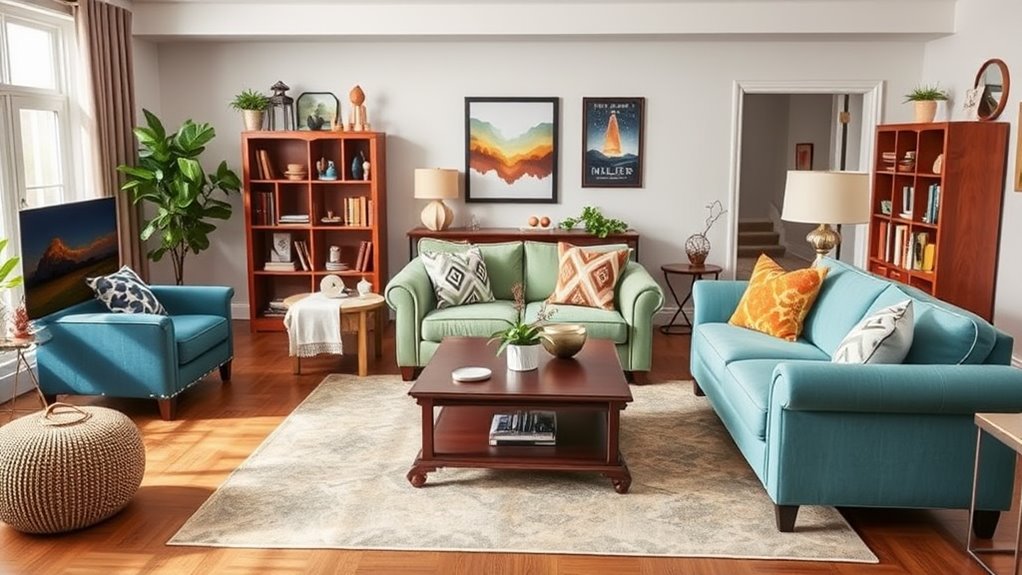
Using movable furniture can considerably transform your living room's flexibility and style. By incorporating modular designs, you can easily rearrange your space to suit different activities and moods.
For instance, consider sofas that float away from walls to create an open area for gatherings or playtime. Wheeled units, such as drawer units and desks, allow you to move furniture in and out as needed, optimizing functionality.
Mobile storage solutions, like kitchen islands on wheels, make it easy to shift items around, helping you utilize your space effectively. Custom-made mobile furniture, such as tables that can be pushed together or separated, adapts perfectly to your needs, whether you're hosting a dinner party or enjoying a quiet night in.
Don't forget about multi-functional pieces! Desks that transform into dining tables can maximize your living room's utility, especially in limited spaces.
Compact designs, such as wall storage and foldable partitions, redefine your layout based on your current activities.
Integrating space-saving furniture with hidden storage, like coffee tables with compartments, keeps your area tidy while looking stylish.
As you mix and match various materials and finishes, you'll not only create an inviting atmosphere but also reflect your personal style.
Experiment With Lighting Styles
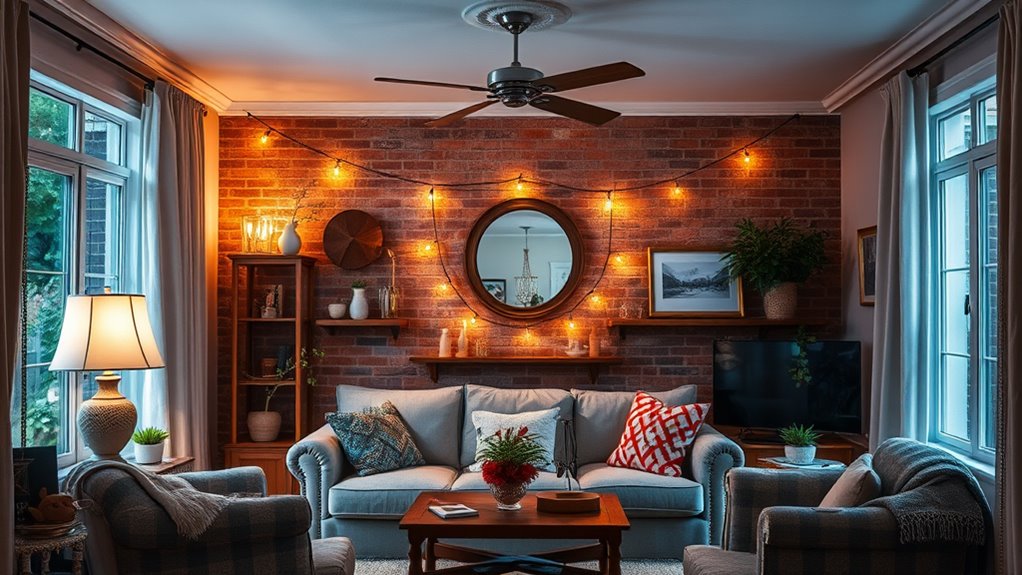
After you've reimagined your space with movable furniture, consider how lighting can further enhance the charm of your living room. Experimenting with different lighting styles can create a warm, inviting atmosphere and highlight the unique features of your space.
Layered lighting is key, combining general, accent, and task lighting to achieve the perfect balance.
Here are three effective ways to play with lighting styles:
1. General Lighting: Use ceiling-mounted fixtures like chandeliers or recessed lighting to provide uniform brightness.
Install LED downlights angled towards curtains or artwork to enhance the room's feel. Avoid a flat appearance by not creating a grid of downlights, and consider adding dimmer switches for adjustable ambient influences.
2. Accent Lighting: Highlight specific features in your living room using wall lights or track lighting.
Picture lights can illuminate artwork at night, while narrow beam lights create focused pools of light around plants or sculptures, adding depth and drama.
3. Task Lighting: Place floor or table lamps near reading nooks for functional lighting.
Choose eclectic styles, from industrial to minimalist, to contribute to your room's character. Position these lamps strategically to maximize vertical space and create cozy, inviting corners.
Layer Rugs for Visual Appeal
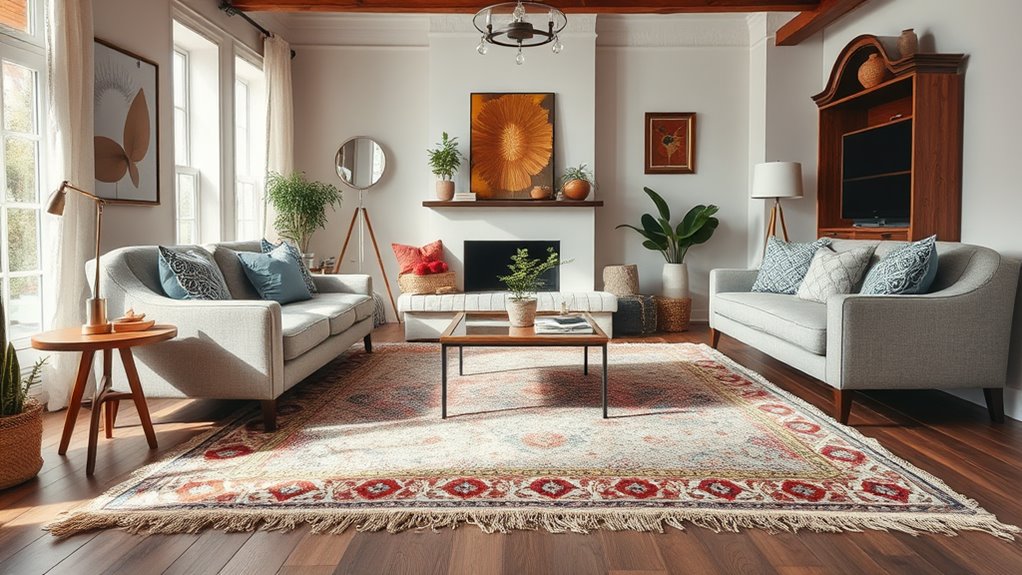
Layering rugs can instantly elevate the visual appeal of your living room, adding depth and character to the space. To start, choose rugs of varying sizes to create dimension. A large rug works great as a base, while smaller rugs add interest on top. Make sure your selections complement your furniture's scale; proportion is key.
When it comes to rug materials, consider natural fibers for a grounded look and plush options for a touch of luxury. One effective layering technique is the overlapping layers method, where you mix rugs of different sizes. You can also employ centered layering by placing a smaller rug directly atop a larger one to create a focal point.
Experiment with angles; layering rugs at different angles can enhance visual interest and balance. Don't shy away from mixing patterns and colors. Combining geometric prints with florals or traditional motifs can give an eclectic charm, but make sure at least one color connects them to maintain harmony.
For a bold statement, choose contrasting colors, or opt for various shades of the same hue for a more subdued effect.
Frequently Asked Questions
How Can I Personalize My Living Room Decor?
Personalizing your living room decor is like painting a canvas with your life's story.
Start with shelf styling that showcases cherished photos, beloved books, and unique trinkets that reflect your interests.
Experiment with various lighting options—ambient, task, and accent—to set the mood and highlight your favorite pieces.
Don't shy away from bold colors or patterns that resonate with you; they'll breathe life into your space, making it unmistakably yours.
What Are the Best Plants for a Living Room?
When choosing the best plants for your living room, consider low light plants like the ZZ Plant or Snake Plant that thrive in less sunlight.
If you want air purifying options, the Peace Lily and Spider Plant are excellent choices, helping to improve indoor air quality.
You can mix and match these plants for a vibrant, healthy atmosphere while ensuring they fit the light conditions of your space.
Don't forget to enjoy their beauty!
How Do I Choose Art for My Living Room Walls?
Choosing art for your living room walls is like selecting the perfect outfit for a big event.
Start by considering different art styles that resonate with you, ensuring they harmonize with the wall textures.
Think about scale—larger pieces can make a bold statement, while smaller works can create a cohesive gallery.
Don't forget to reflect your personality, mixing colors and themes that bring joy and warmth to your space.
What Are Some Budget-Friendly Decor Ideas?
When you're looking for budget-friendly decor ideas, consider hunting for thrift store finds. You can discover unique pieces that add character to your space.
Pair these with simple DIY projects, like painting old furniture or creating wall art from fabric scraps. Adding warm textiles like cushions and throws can make a big impact without breaking the bank.
Embrace creativity, and you'll transform your home into a charming retreat on a budget.
How Can I Create a Cozy Atmosphere in My Living Room?
Creating a cozy atmosphere in your living room is like wrapping yourself in a warm blanket on a chilly evening.
You can achieve that by using soft lighting, like warm-toned bulbs or candles, to cast a gentle glow.
Layer your space with warm textiles—think plush throws and soft cushions—to invite relaxation.
Arrange your furniture for conversation, and add natural elements like plants to breathe life into the room, making it a welcoming haven.